By the time Labor Day weekend of 2023 rolled around, I had lived in New Mexico for over two and a half years, but somehow never got around to visiting the state's biggest city. I'd flown out of and into the airport there a few times, and I had a doctor's appointment in the city once, but I'd never actually looked around at anything or spent the night there. But then in the summer of 2023 I found out that Pantera, one of the '90s' most legendary metal bands whose surviving members had just reunited and were doing a long worldwide reunion tour, would be in Albuquerque on August 31. For me that was the night before a four-day weekend, so finally I was going to see what Albuquerque had to offer.
Thursday, August 31, 2023
I managed to get out of work about an hour early, but still got badly delayed due to all the road construction all over US Highway 60. I'm glad to see so much road construction in the last couple years, but it still can be frustrating, especially when I'm trying to reach someplace at a certain time.
I finally made it to the Isleta Amphitheater, a bit south of the city on I-25, just in time. I'd completely missed the opener, a local band called Spirit In The Room. As I hiked from where I parked my car, one of the furthest spots from the venue, I could hear the last few songs from the second band, Lamb Of God. During the last intermission between Lamb Of God and Pantera, I got my ticket scanned and let into the venue. I got myself a beer and found a spot to stand with a good view.
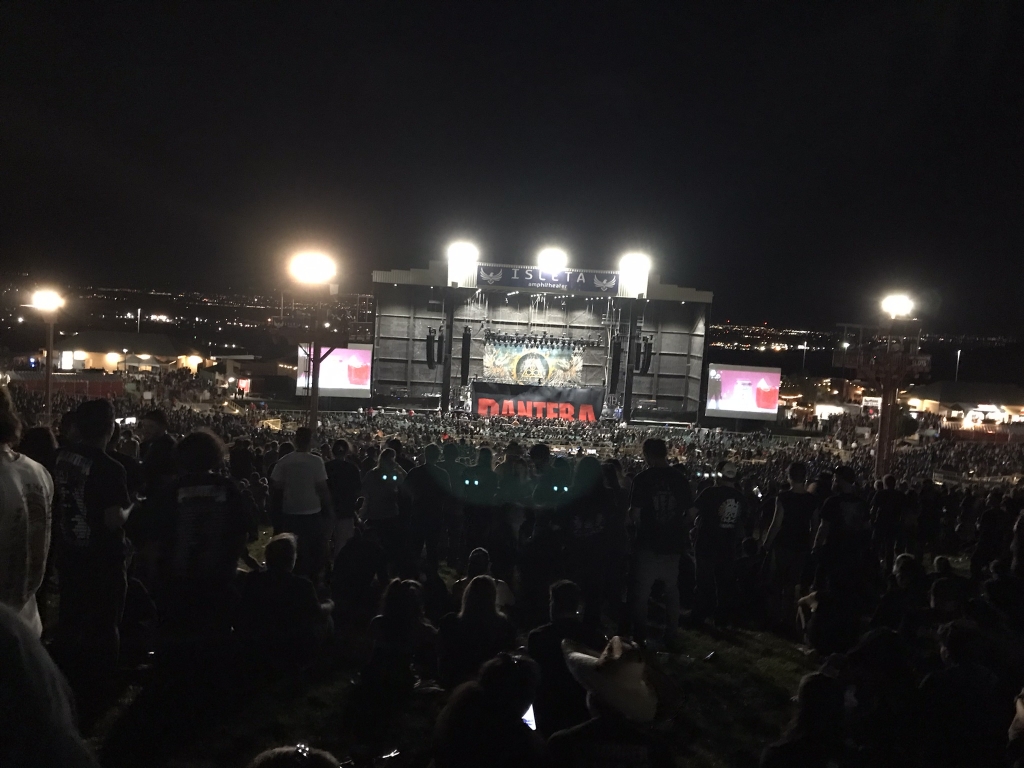
Still a few minutes to go.
I never got a chance to see Pantera back in their glory days. I didn't even start listening to them until after they released their last album and were on what ended up being their last tour before splitting up. Then with Dimebag Darrell's untimely death in 2003, it looked like I'd missed my chance forever. So when this big reunion tour started, with Zakk Wylde and Anthrax's Charlie Benante replacing the late Dimebag and Vinnie Paul, I knew I'd have to find my way to one spot or another on this tour. I've heard some people say "it's not really Pantera" and "it's really only a tribute band" because it's only half the classic lineup, but this was still the closest I was ever going to get, and I felt it was more than close enough. This 90 minute show was everything I expected and didn't let me down.
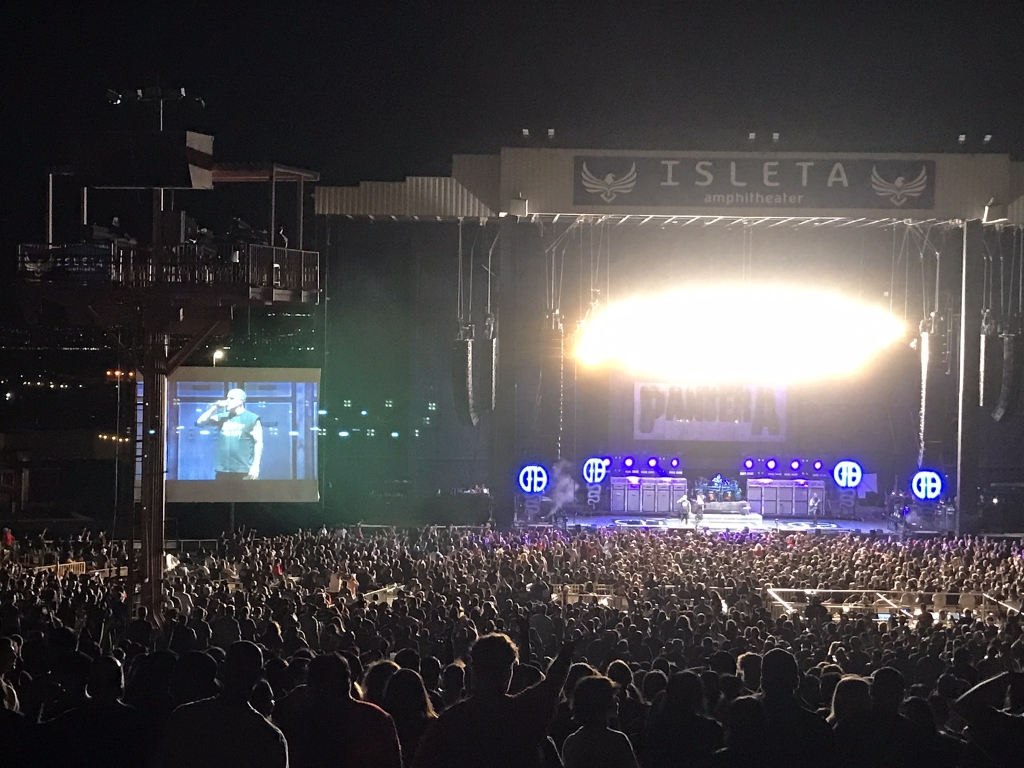
After midnight I made it to my hotel, which was going to be my home base for this long weekend: Quality Inn & Suites Downtown-University Area. It was right next to the intersection of the two great Interstate highways 25 and 40. While it wasn't in walking distance of either downtown or the university, it did have a bus stop in front and I'd hoped to leave my car here for the whole time. The city's transit system wasn't good enough for that, though.
Friday, September 1, 2023
The Quality Inn served the usual "hot breakfast" you'd expect from such a place, with scrambled eggs, sausage, biscuits, gravy, along with the waffles, cereal, fruit, and coffee. I got my fill of this and walked out to the bus stop.
Friday was the only day of this whole trip when the bus system worked as it should. Bus 8 pulled up in front of the hotel at 10:30, and for whatever reason it was free of charge that day. When I arrived downtown, I needed another coffee, so I went to a coffee shop called Humble, on Central Ave. near the intersection with 5th, for an Americano.
I didn't have a plan for the morning, but while walking on Central Ave. I found a place that looked interesting: the Telephone Museum of New Mexico, which turned out to be a worthwhile walk through the history of telecommunications technology.
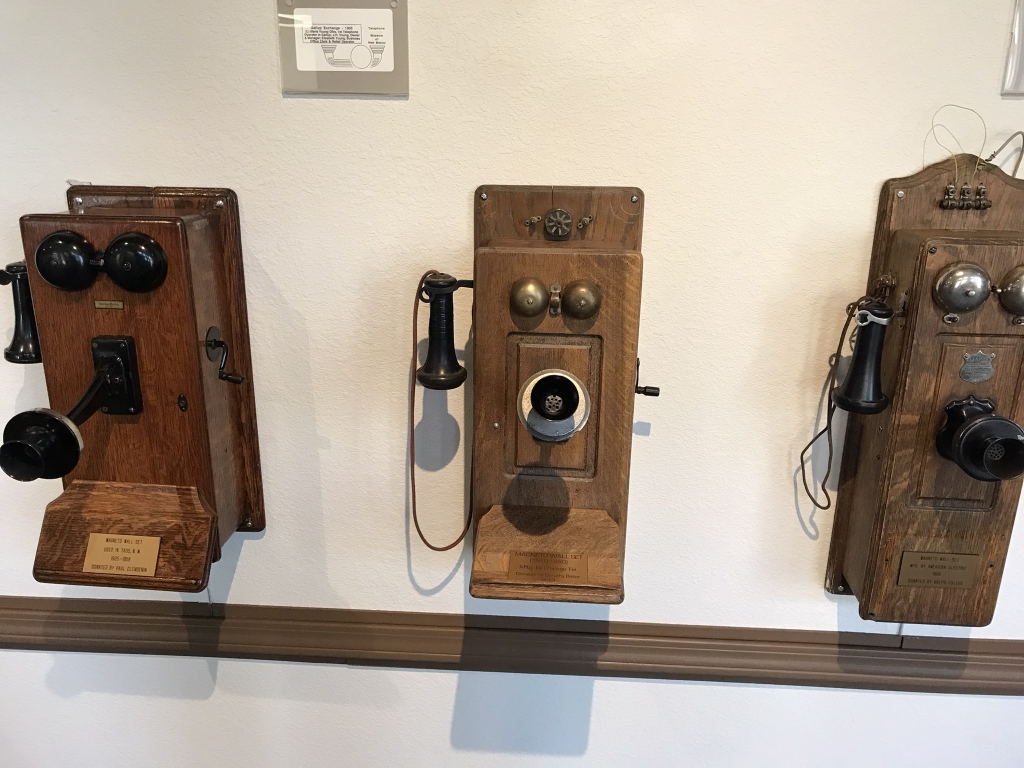
One of the first things you see after you pay for entry is a wall full of old wall-mounted phones like these, from the very early 20th century. On the left side of each is a speaker hanging from a wire, which someone back then would hold up to their ear while speaking into the microphone sticking out of the box. I'm not really sure how it worked, but I think it would connect the user to an operator at a local office, to whom you would speak the number you wanted to be connected to.
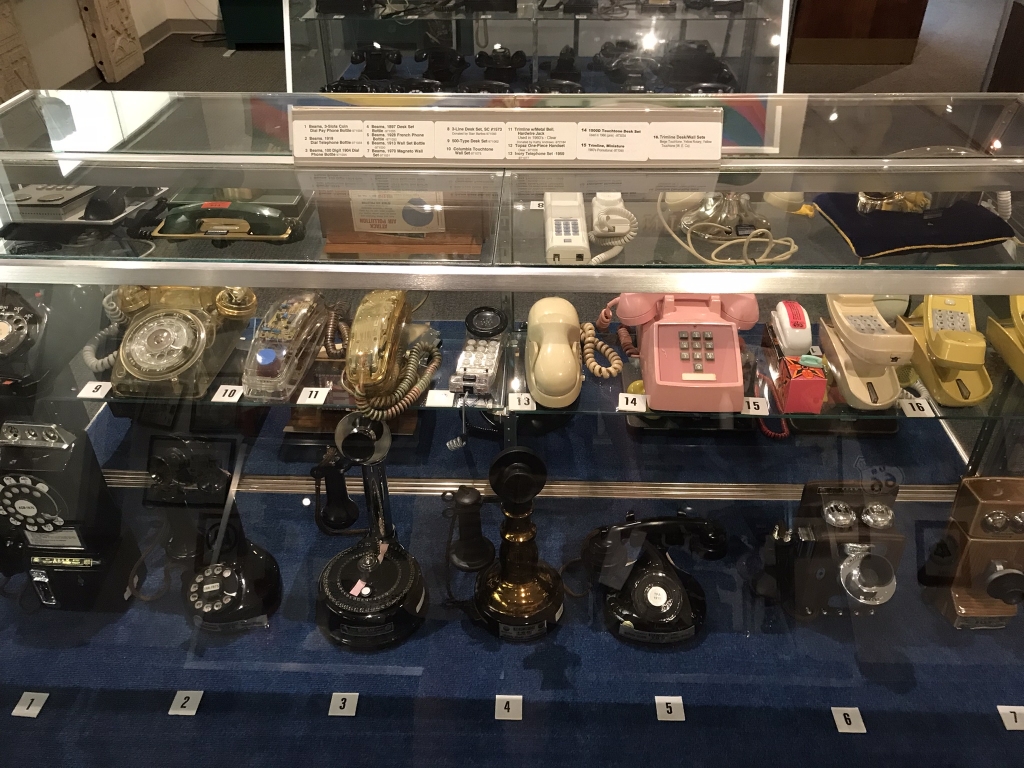
Some more phones of various eras.
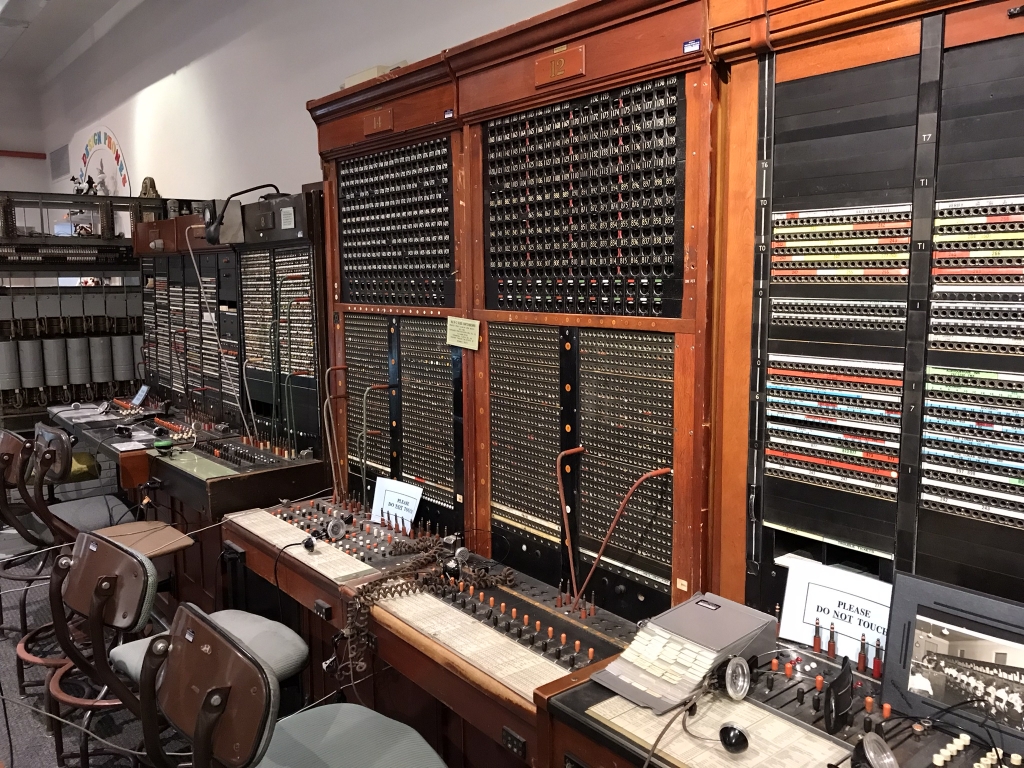
Examples of the switchboards that operators used to work. The two in the middle look to be the oldest.
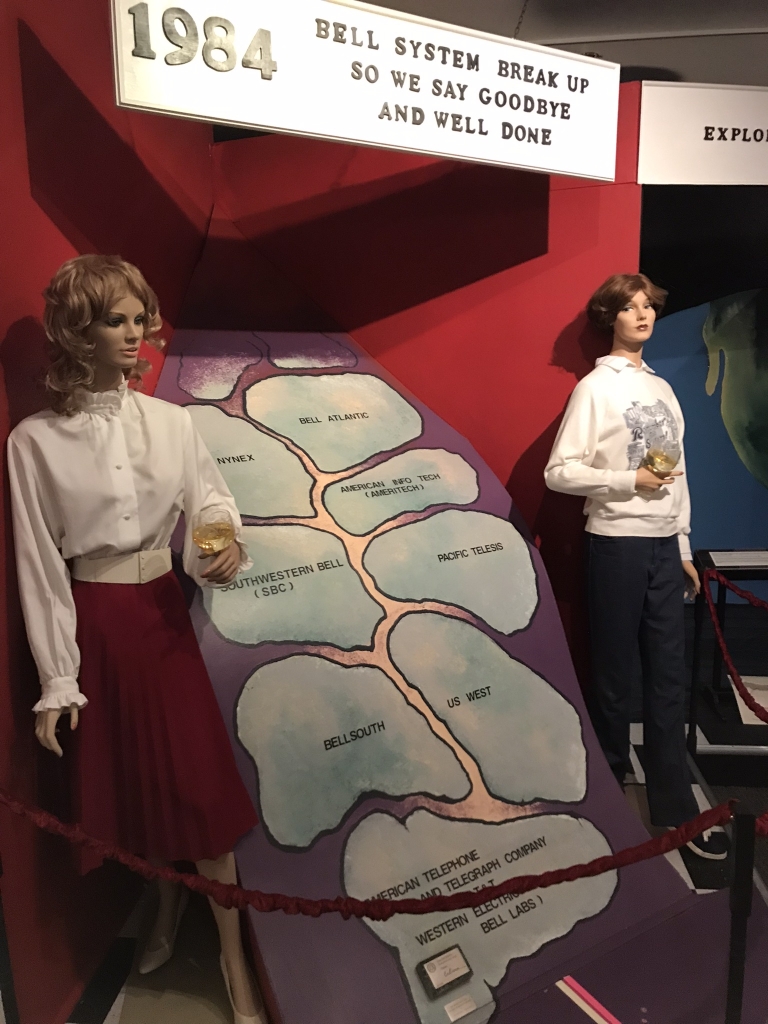
One room was full of exhibits about the old Bell System, a network of companies, all subsidiaries of AT&T, that once controlled all local telephone infrastructure throughout the US. Thanks to a successful antitrust lawsuit brought by the Department of Justice, a federal court ruled that the system was a monopoly and it split up into seven regional companies in 1984.
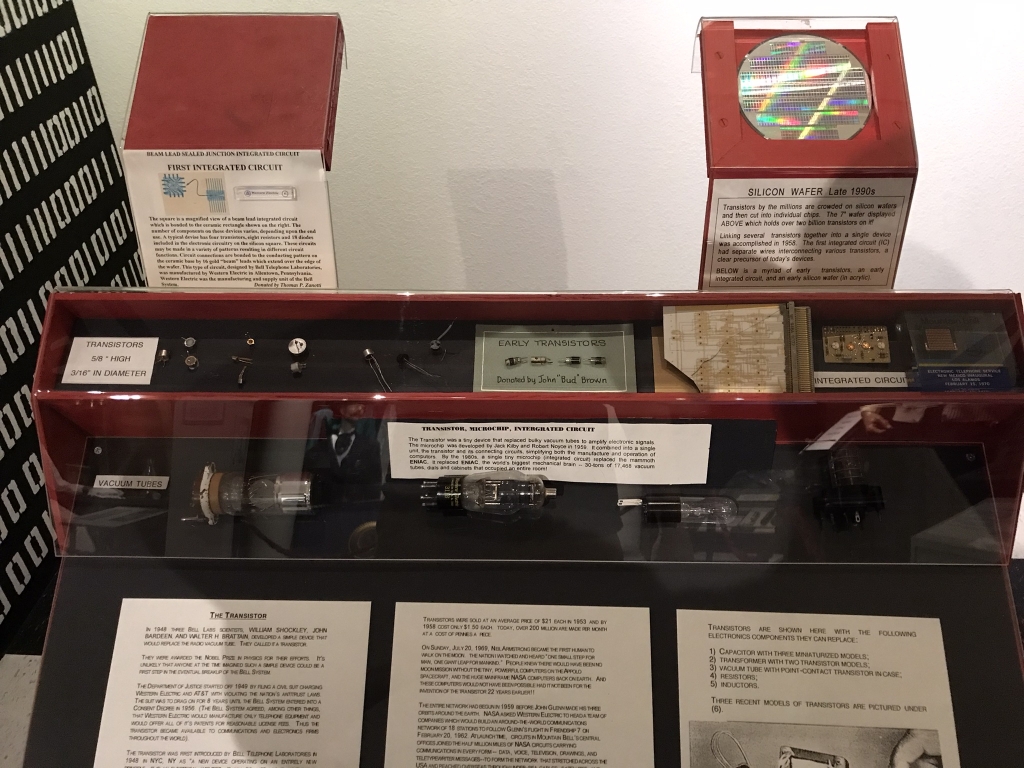
A display case full of examples of vacuum tubes, transistors, and integrated circuits.
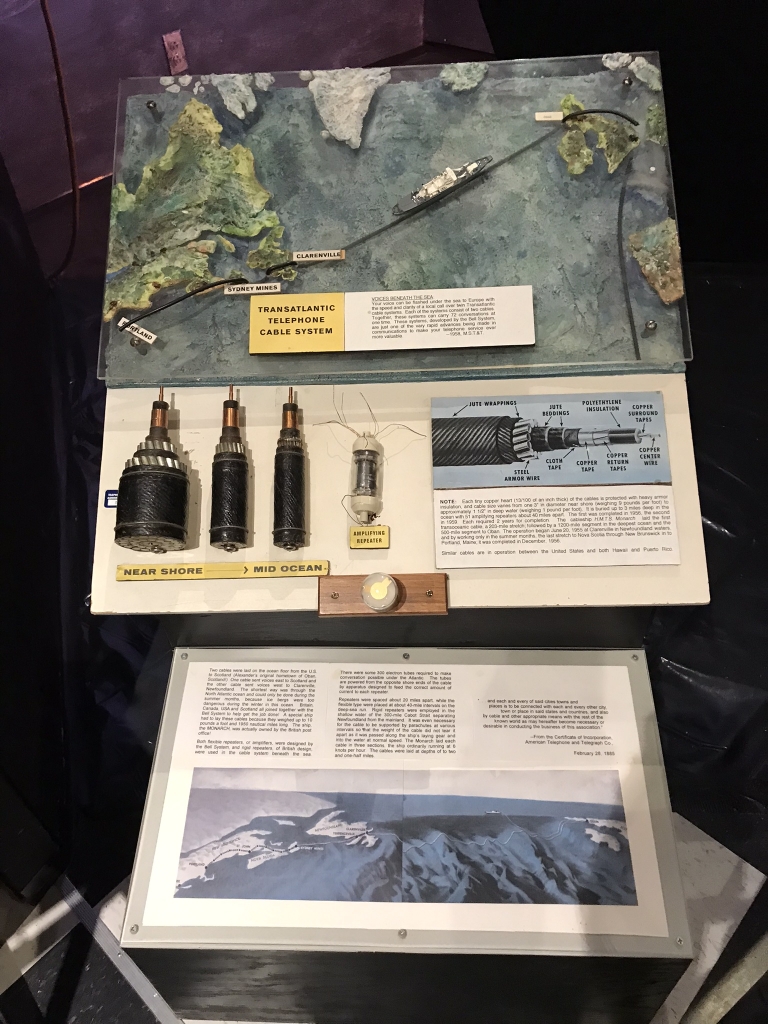
Model of a transatlantic cable, along with cutaways of the same kind of cables that are laid under the ocean.
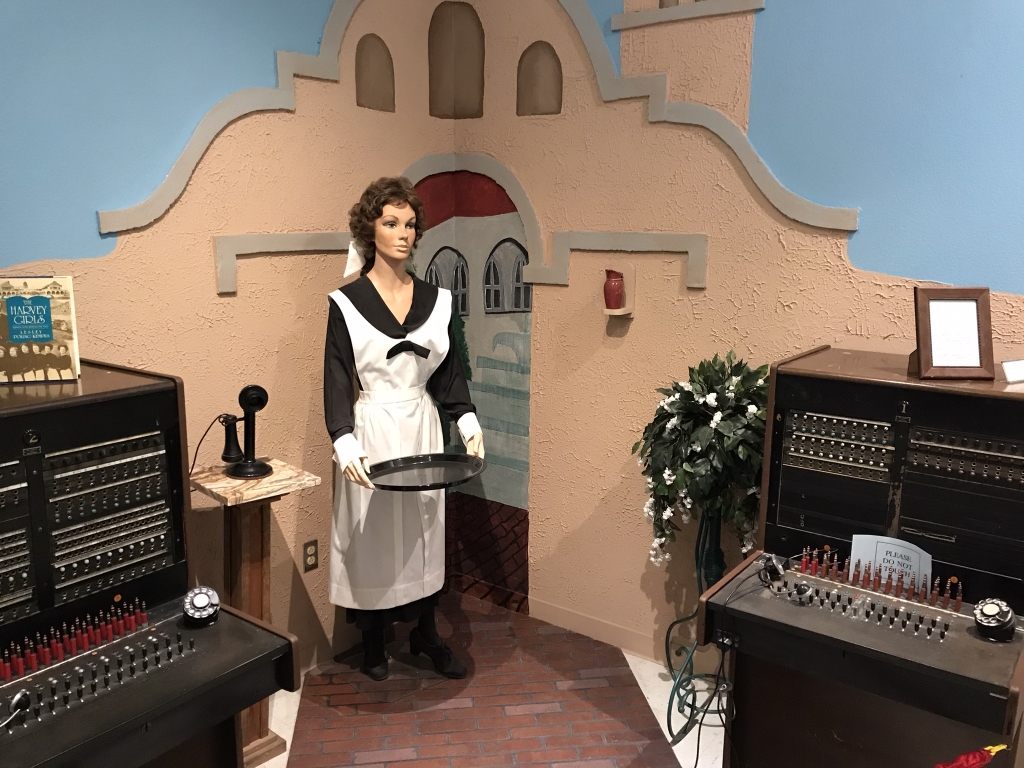
Switchboards that used to be used in Harvey Houses, the combination train station/hotel/restaurants that used to be found all over the old Santa Fe Railroad. In the middle is one of the "Harvey Girls" that used to work there.
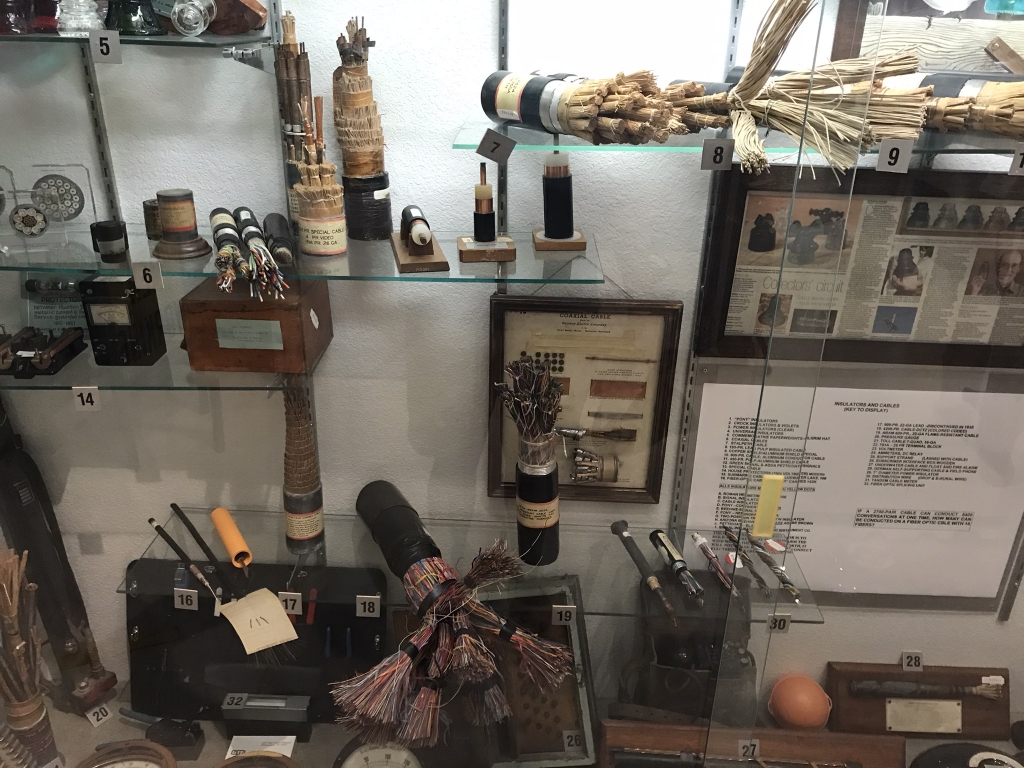
More insulators and cables than I know what to do with.
After the Telephone Museum, I needed to get lunch. At another spot on Central Ave. was the 505 Central Food Hall. One of the restaurants within was called Kukri, from where I got my lunch, a garden salad with chicken. Then I thought a beer would be nice so I went to a bar in the hall called Moonwalk...
I got a La Cumbre Oktoberfest ale thinking that would be the only one, but there was someone else at the bar who was at the concert the night before, so while we were talking about this, that, and the other thing, I got a couple more pints. One was a Marble Mexican lager, and the last was Ex Novo amber.
After all the time spent at the bar in the food hall, and after three beers, I felt done for the day and so rode bus 8 back to the hotel.
Well, maybe not completely done for the day. I also wanted to swim some laps at a local pool at some point during this weekend, and now had some time to do it. This is the first time I needed my car during the trip, to drive down to the Los Altos pool. As far as public indoor pools go, this one was pretty nice. After I got my laps in, I drove to a nearby restaurant with a 50s-60s diner theme, The Owl, for dinner, a "Health Nut" salad.
After dinner, then I was done for the day.
Saturday, September 2, 2023
Today I had more of an idea of what I wanted to do. Unfortunately, this was also when I started having issues with the local bus system. After breakfast I went outside to wait for the bus again, which should've showed up only a few minutes later, but I wound up waiting...I don't remember how long anymore. I think it was at least an hour, and it was not even close to any scheduled time. I don't know what was going on with the buses that day.
Back downtown, I returned to the coffee house from the day before, Humble, and this time got a mocha. Now I had a plan: I wanted to visit the National Museum of Nuclear Science & History, and I wanted to ride Albuquerque's bus rapid transit line to get there. So after procuring my coffee I walked to the Barelas bus stop at Gold & 6th and waited.
Bus rapid transit (BRT) is an idea that is only beginning to catch on in US cities. I've seen it described as "light rail on wheels" at least once. BRT involves long buses, the kind that bend in the middle, that travel in dedicated lanes that cars are not allowed to drive in. So it's a bus, but like a light rail train in that it doesn't get stuck in car traffic, and it's meant to be attractive to city planners who want to implement light rail but are averse to spending the tax money on it. Additionally, the stops on the route look and feel less like bus stops and more like light rail stations with elevated platforms under shade. In all the cities I've visited, I've never ridden in a BRT bus before. I'm not sure I've even visited anywhere that has BRT, before Albuquerque. I know Austin is planning to implement a BRT line, but I don't think it's happened there yet.
Bus 777 pulled up to Barelas on time and soon I was riding it eastward down the old Route 66. The ride was just like any other bus ride, except of course, it ran outside of car traffic. So whenever traffic was backed up at an intersection, the bus just sailed right past it. Some of the stops were not on the sides of the road, but on the median strip that ran down the middle. What I remember the most was one person who boarded the bus with a couple food trays, and gave away pieces of hot dogs in buns to anyone who wanted one. I turned it down because I wasn't hungry, but I still liked the feeling of being in a community.
A YouTuber I follow, CityNerd, recently made a video about Albuquerque's BRT line.
I stepped off the bus at the Central/Eubank intersection. My destination was a little bit to the south, and just looking at the place and its location, I can tell that they never expected anyone to ride a bus and walk there.
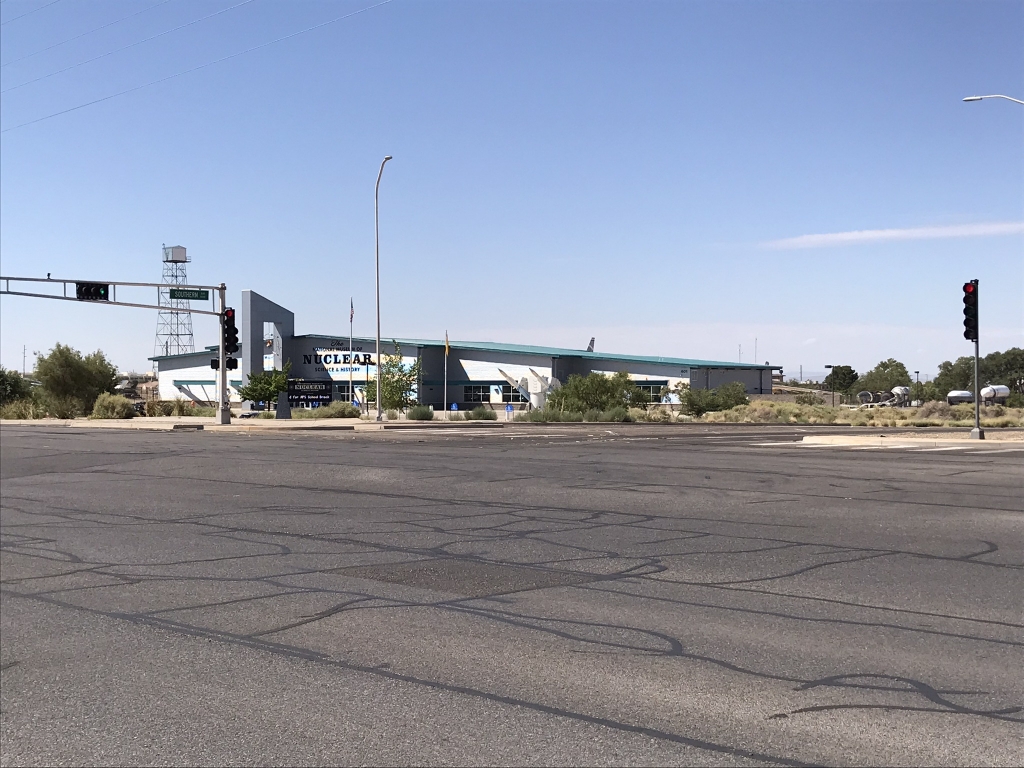
The National Museum of Nuclear Science and History
The atomic bomb was first developed in New Mexico during World War II, in what was called the Trinity Project. During my visit to Santa Fe, we saw the spot where scientists used to board a secret train to the secret lab in Los Alamos.
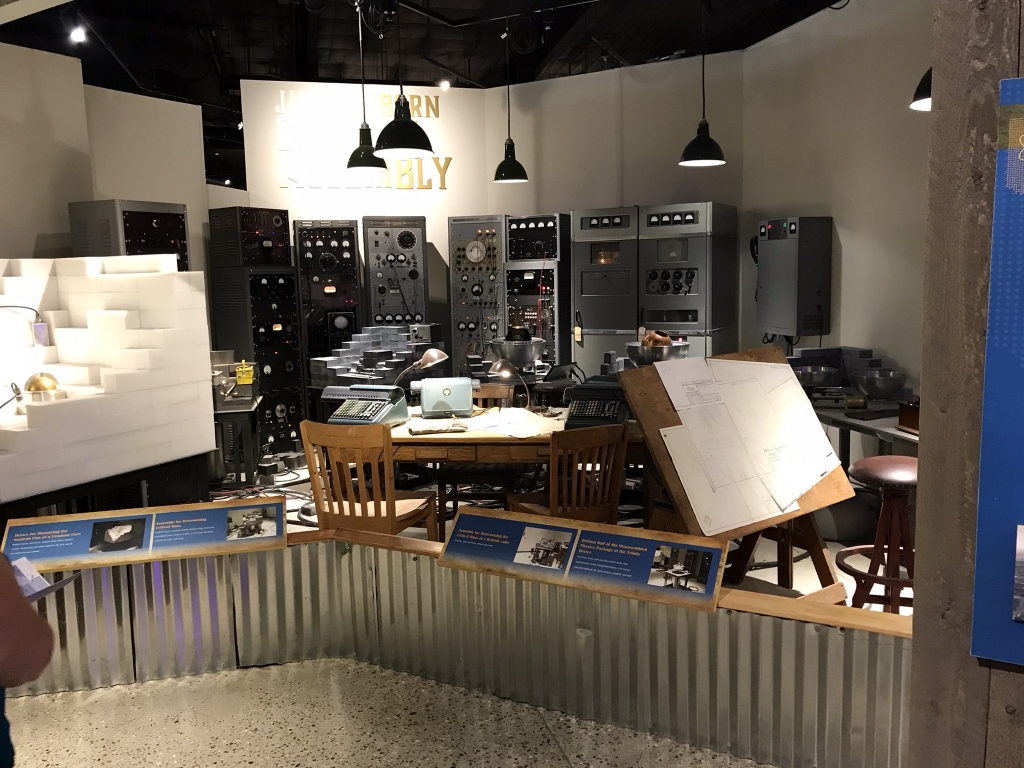
Reconstruction of one of the rooms where the bombs were designed, containing several devices that were actually used in the project.
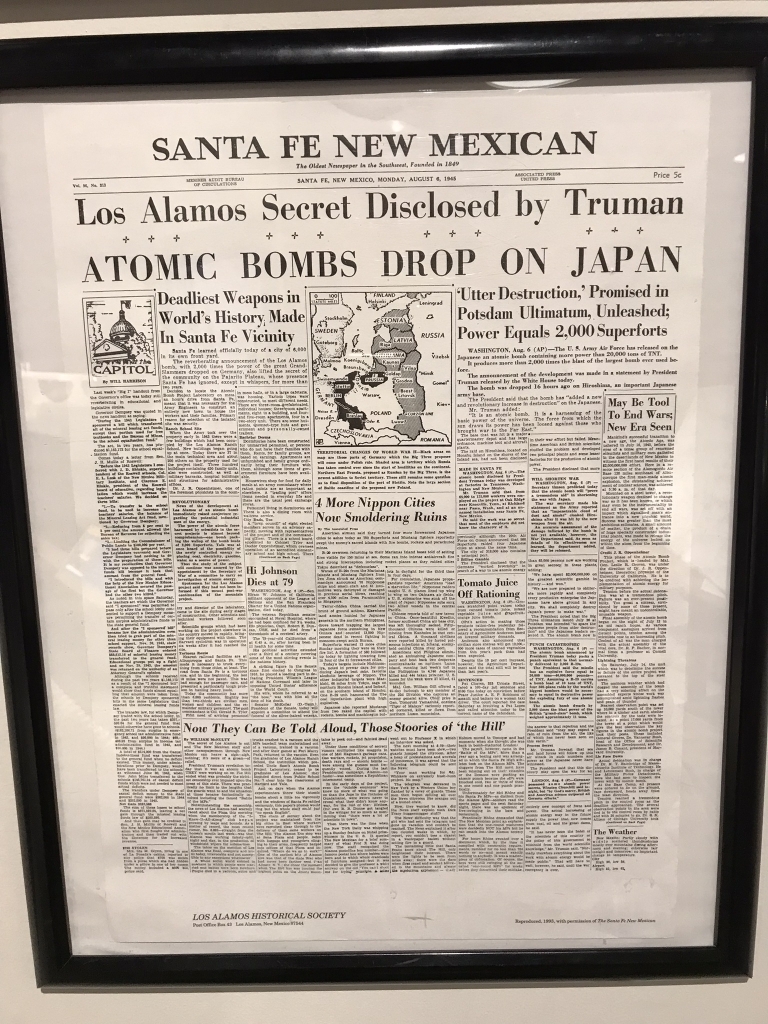
The newspaper headline on August 6, 1945
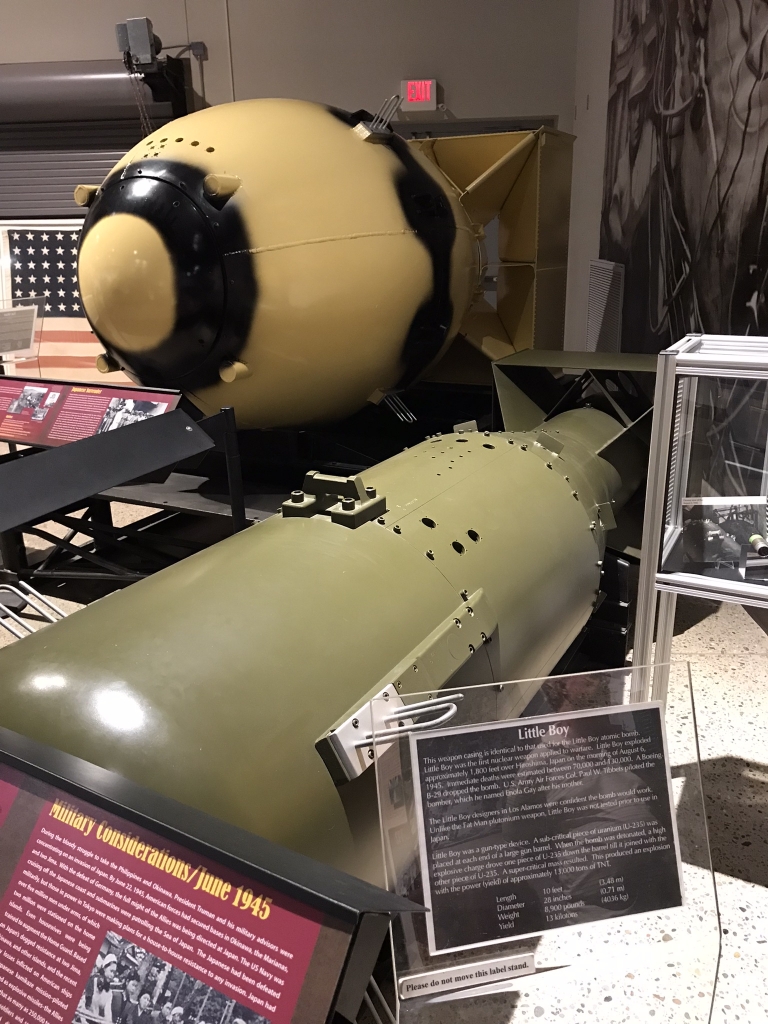
Replicas of "Fat Man" (top) and "Little Boy" (bottom), the atomic bombs that were dropped on Nagasaki and Hiroshima, respectively.
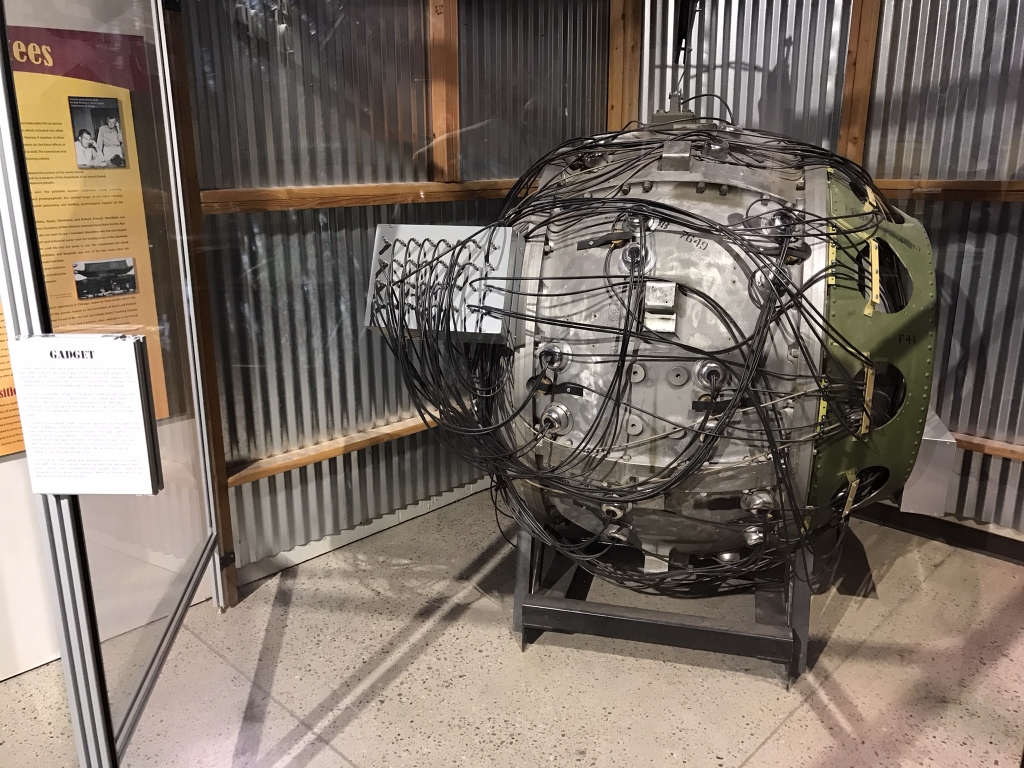
This is a replica of "Gadget," the bomb used in the final test. It was dropped from a 100-foot steel tower--we'll see a replica of that in a bit--in the middle of the New Mexico desert, on what is now the White Sands Missile Range.
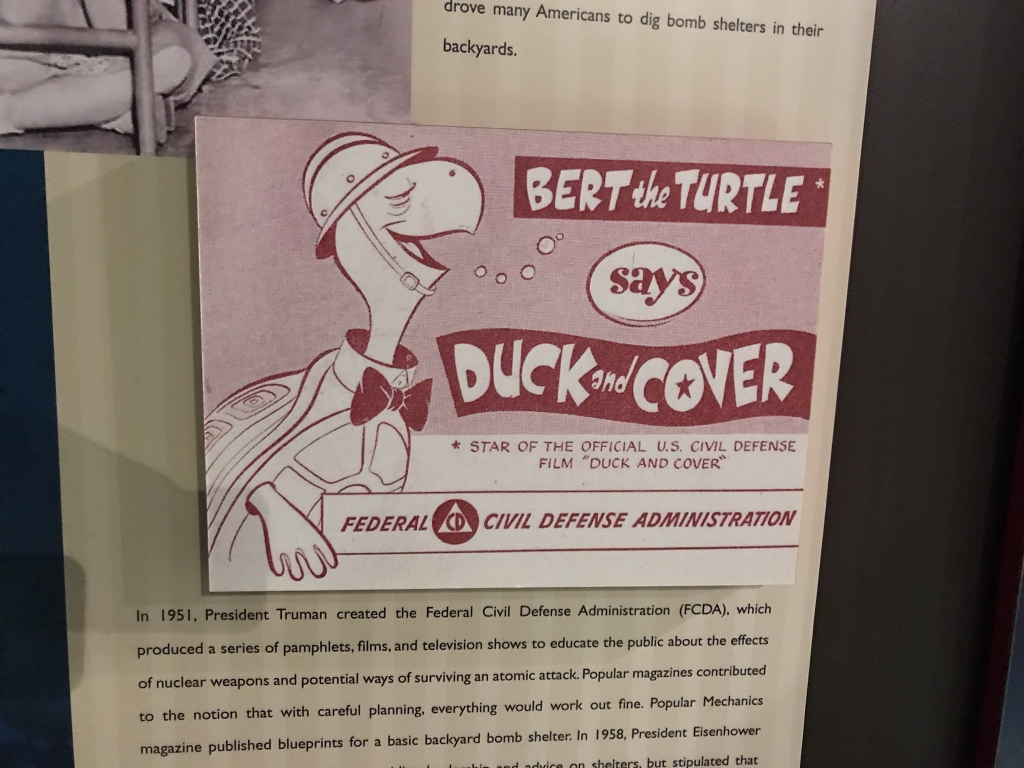
Have you ever seen "Duck and Cover"? I saw it once in a college US History class. This short kids' film, about what to do in the event of a nuclear attack, was screened in elementary schools all over the US back in the '50s.
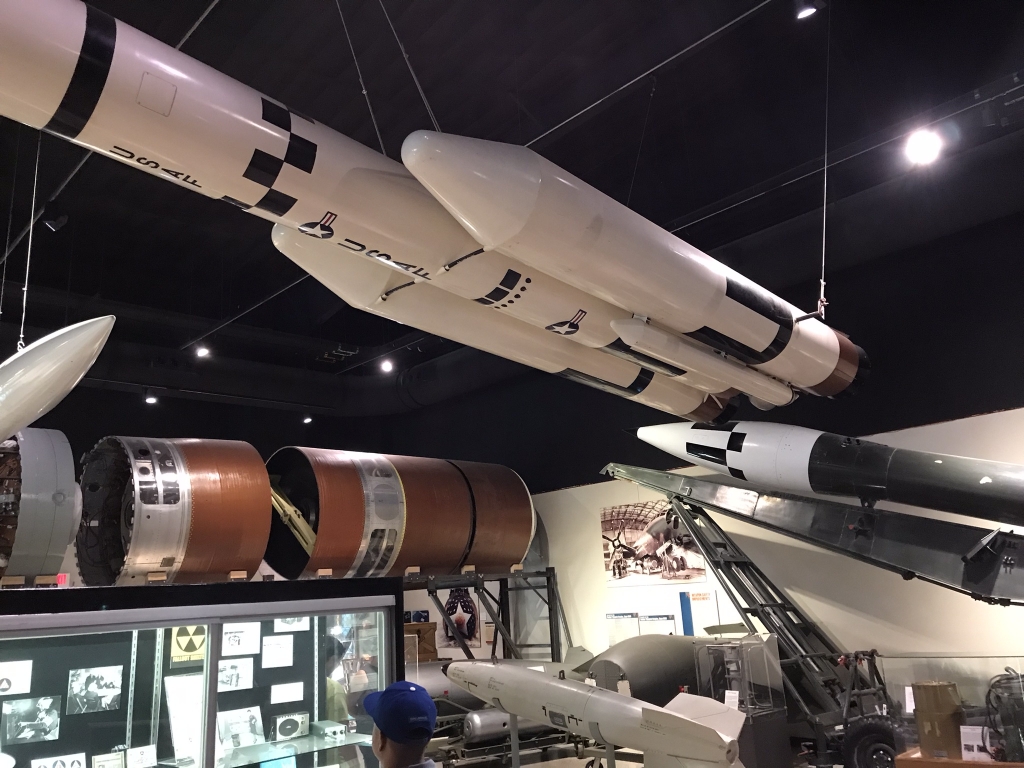
Various missile replicas on display in this part of the museum.
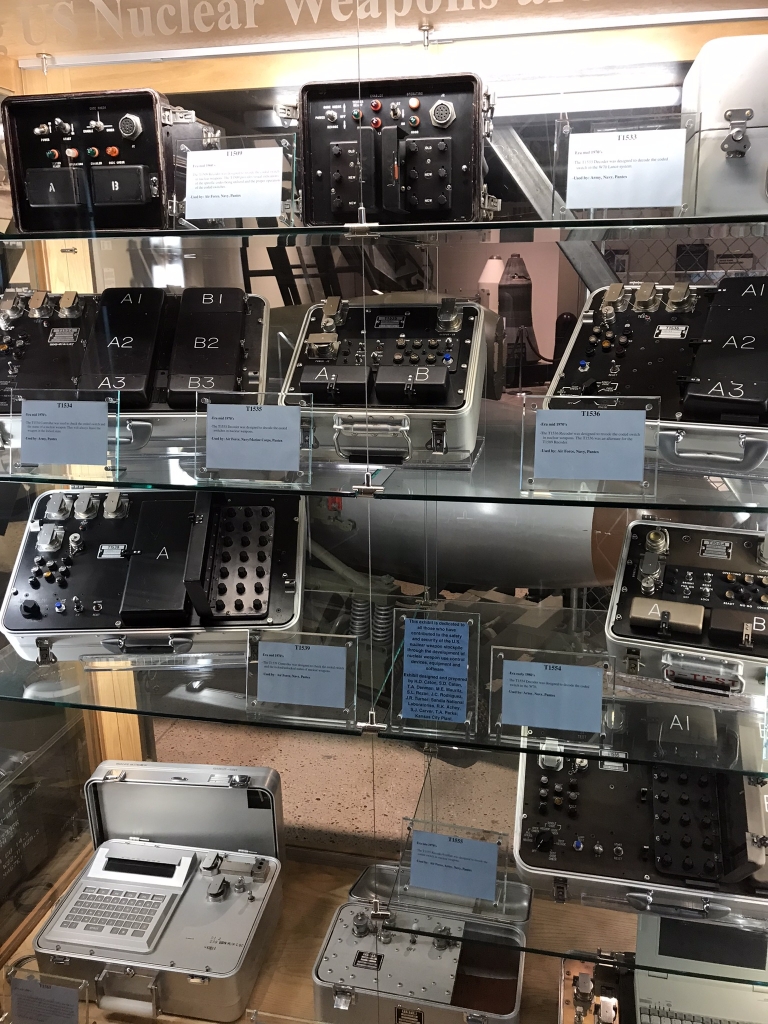
Devices from different decades used to input launch codes.
Now let's step outside for a bit...
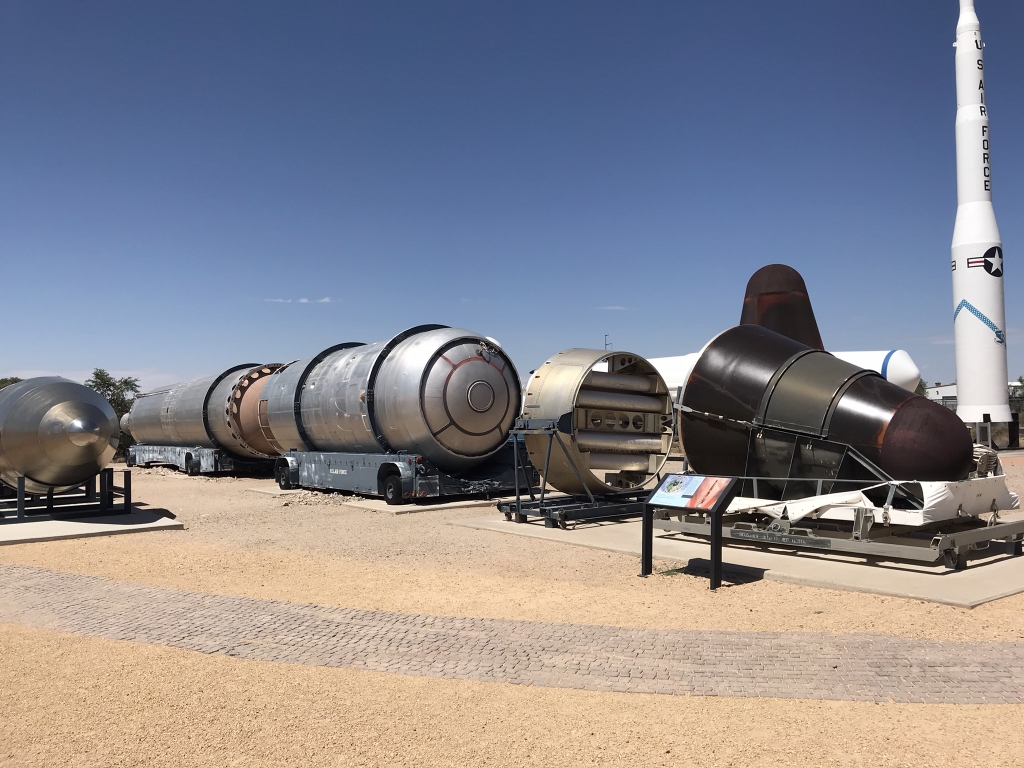
A Titan II ballistic missile, the same kind that used to launch the Gemini spacecraft in the mid-'60s.
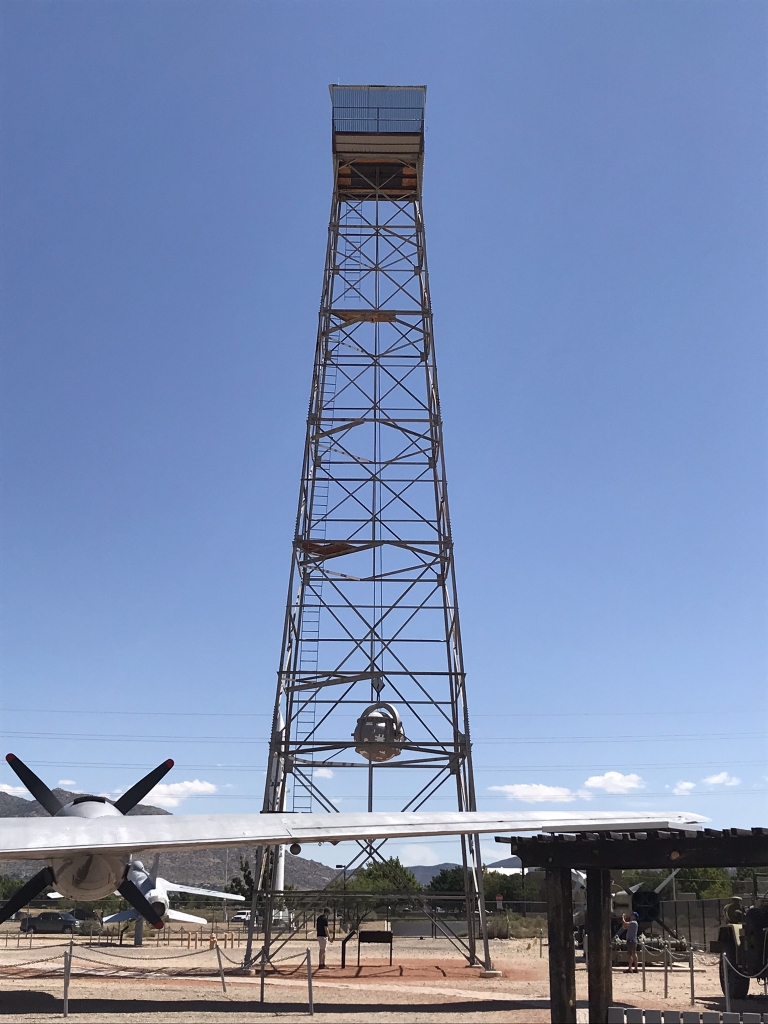
Replica of the 100-foot tower from which the test bomb Gadget was dropped.
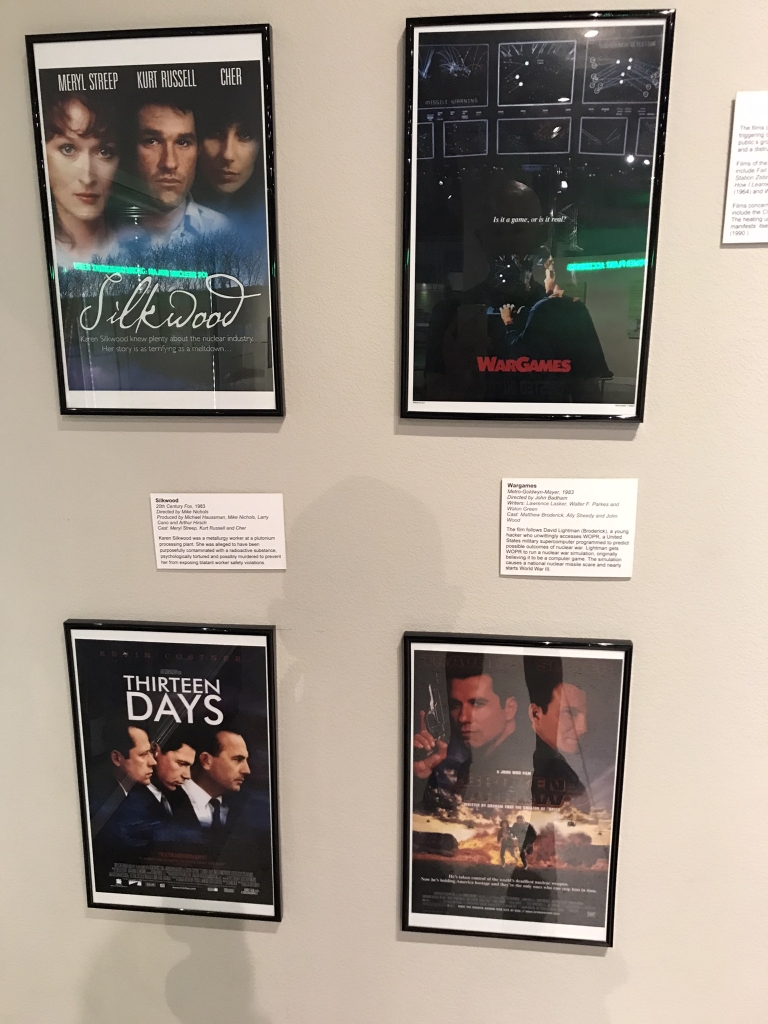
Back inside, there's another area about the nuclear age's reflection in entertainment.
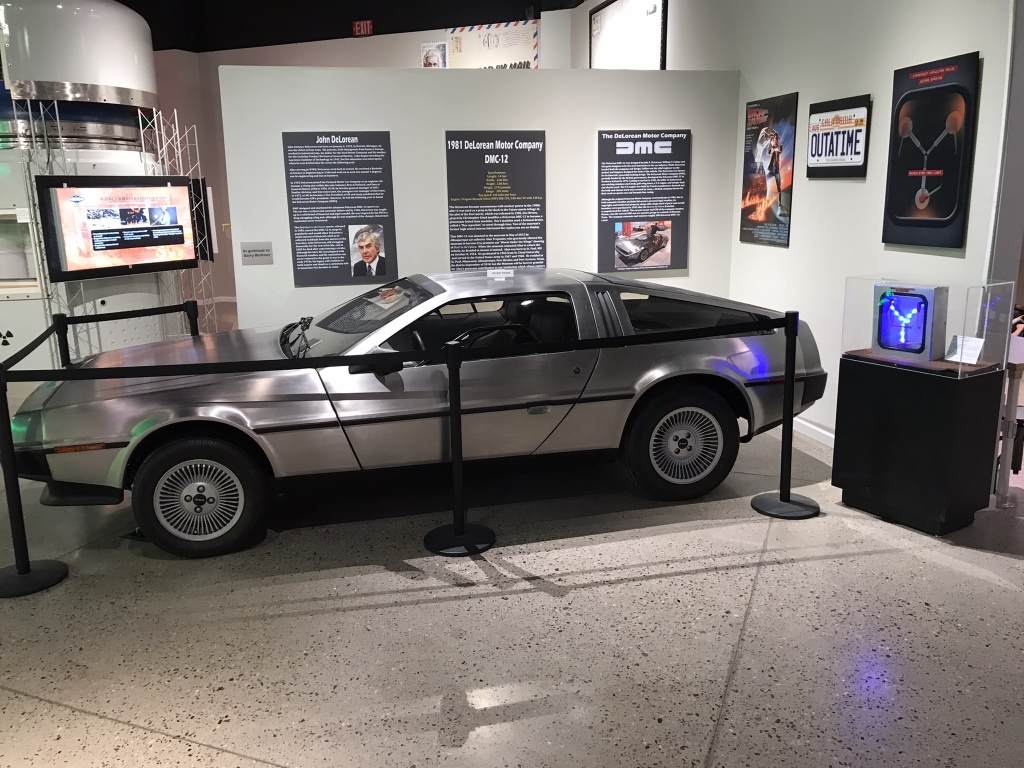
And of course we can't talk about the nuclear age's reflection in entertainment without mentioning Back to the Future with its plutonium-powered time machine.
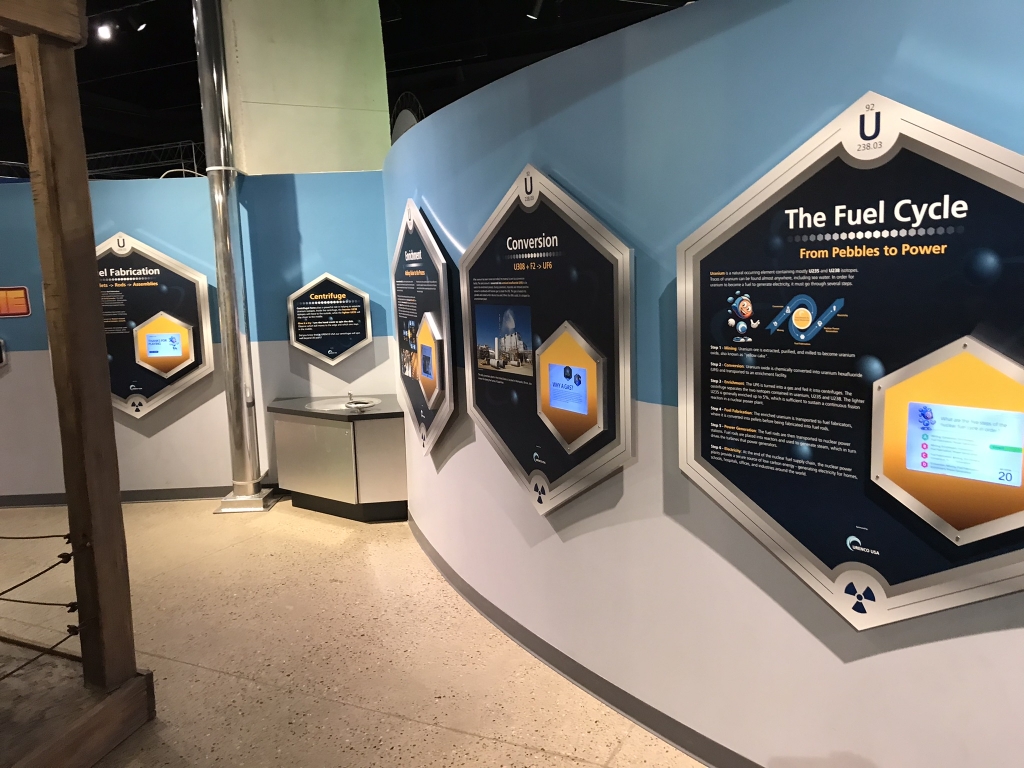
Now this area is all about nuclear power generation.
The last area of the museum I walked through was about both radioactive medicine and radioactive quackery. On display here they had several generations of medical imaging devices...
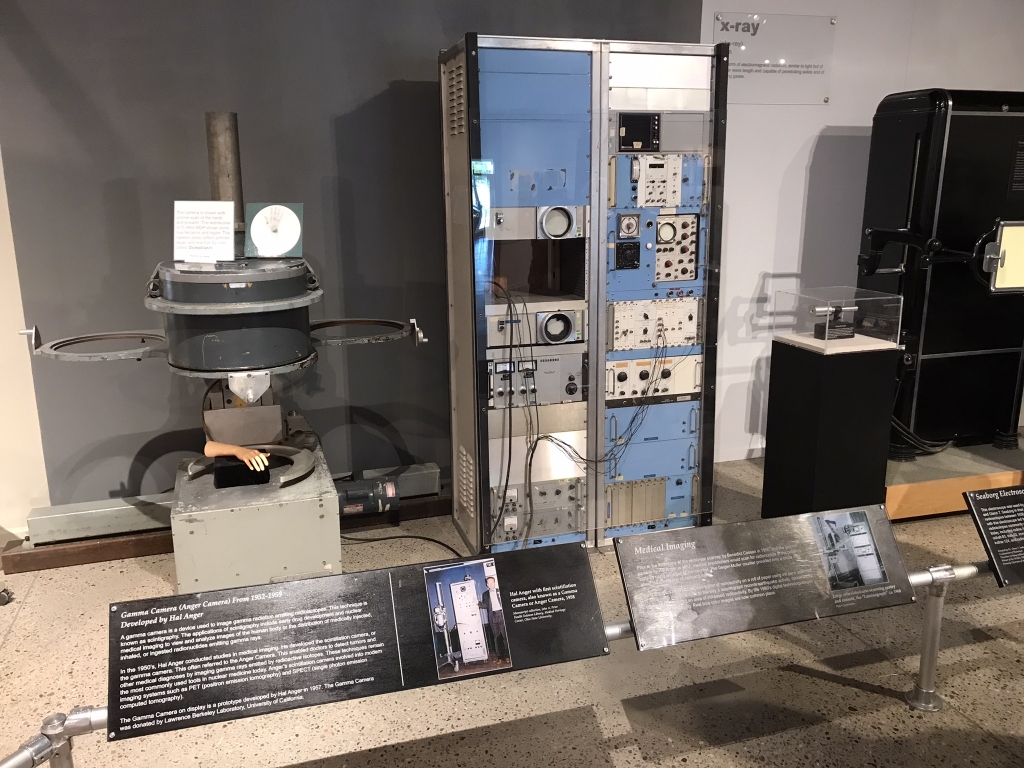
These devices all used gamma rays to produce medical images.
But in that same area was another interesting history lesson. Early in the last century, from about 1900 to 1930, a great many "medicinal" radium products proliferated widely. Mostly they didn't do much besides irradiate people. Some examples of these things are on display here. And then there's this fascinating relic:

Have you ever seen anything like this? It's a shoe-fitting fluoroscope that was common in American shoe stores from the 1920s through the '50s. Someone back then would try on shoes off the shelf, then stick their feet in the holes, then look through the scope and see an x-ray image of their feet, seeing if the shoes fit. People just loved sticking their feet in the machine, wiggling their toes around, and watching the bones move. You can certainly see the issue here: people were getting their feet and faces blasted with x-rays that were often beyond the safe exposure limit. Usually this wasn't a problem for most customers, who weren't going into a shoe store more than once or twice a year, but it certainly was a problem for shoe store employees who were around the things every day. Most US states banned them in the '60s.
After the museum I walked back to the Eubank bus stop, and found myself waiting so much longer than I should have in the hot sun. The next 777 was late too. Something was going on that weekend to make buses late.
Eventually, bus 777 finally showed up, and this BRT bus cruised past all the traffic on Central Ave./Route 66 to bring me back to the Barelas station where I had started my trip to the museum that morning. The next place I wanted to go was the planetarium in the New Mexico Museum of Natural History and Science. I've seen more than enough natural history museums lately, but I'm always up for a planetarium show. I walked there from Barelas, and that turned out to be a long hike in the heat.
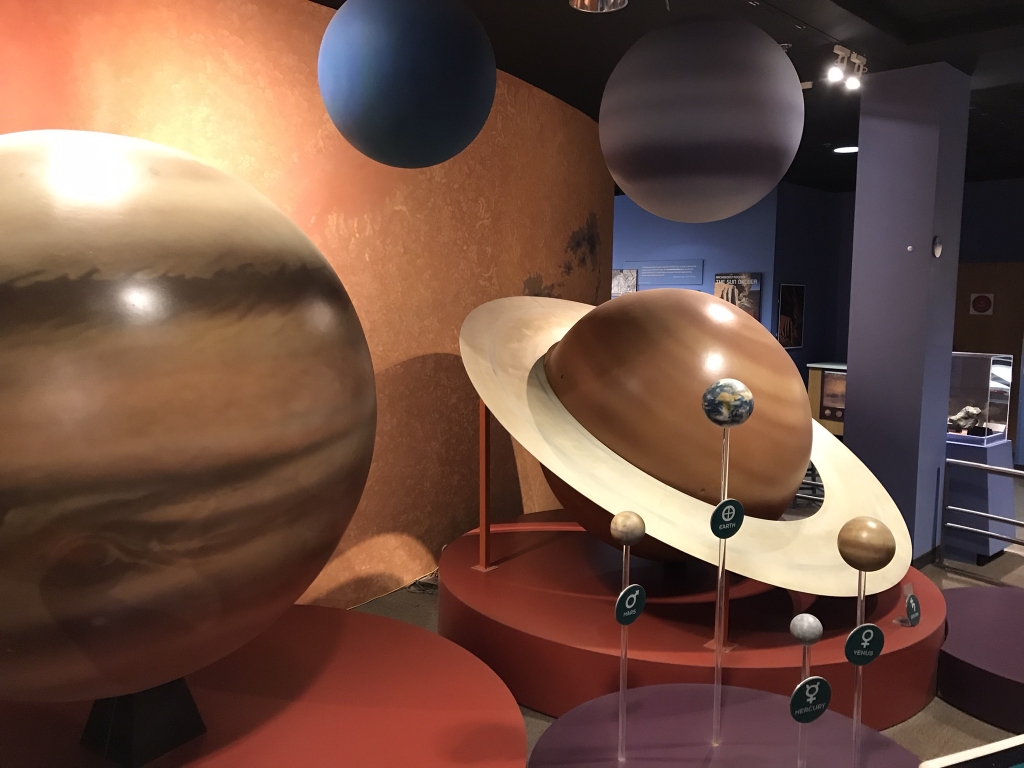
The planetarium show I saw was called "Mayan Archaeastronomy." The first half was about positions of stars, and the second half was about...something to do with what the Mayans knew about astronomy. This is really embarrassing to admit, but I slept through the second half of the show. This isn't because of anything to do with the show, at all! The long walk in the hot sun, from downtown all the way to the museum, had made me tired enough that I couldn't stay awake after sitting down, especially in a dark room.
After the show, it was time to find dinner, and then do some bar hopping. The museum was right next to the Old Town neighborhood and there were some great options there. At Seasons Rotisserie, I got an iced coffee to help wake myself up, a garden green salad with salmon for dinner, and my first beer of the night, Bosque Brewing Pistol Pete's 1888 blonde ale. The beer wasn't great, but just OK for me.
Next I found a modest-looking place called The Taproom At Old Town, right next to a restaurant called Kitsune. This establishment was selling beer and liquor made by the locally-based Palmers Brewery and Left Turn Distillery. I probably stayed here too long. I started with a ten-ounce Dunkel; not bad. Then I had an Ala Grrr Mexican Lager, which was great. After that I moved into cocktails, and they made some pretty good and original ones there. One I had was called The Cure, made with New Mexico Blue Corn whiskey, lemon juice, house-made ginger simple syrup, and fresh mint. That was great and I loved the minty flavor. And finally I had a Rojo Russian...
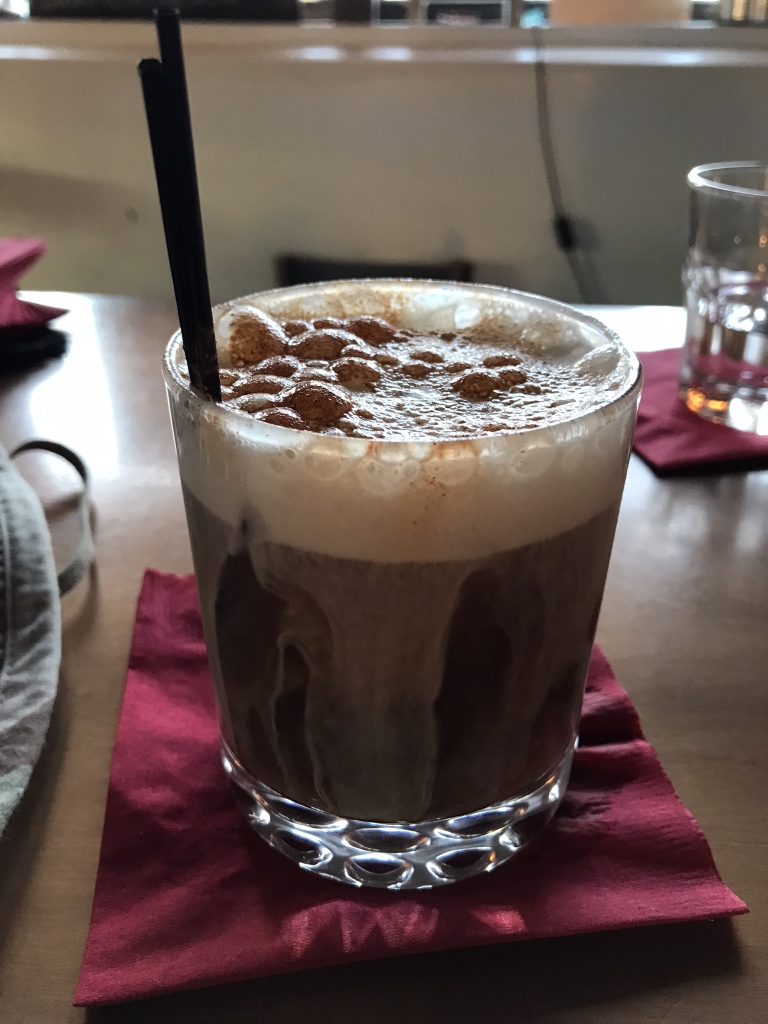
This was delicious, and I don't say that often about boozy cocktails. The Rojo Russian is made with Left Turn Distilling's La Luz red chile vodka, Left Turn coffee liqueur, cold brew coffee, and foam on top.
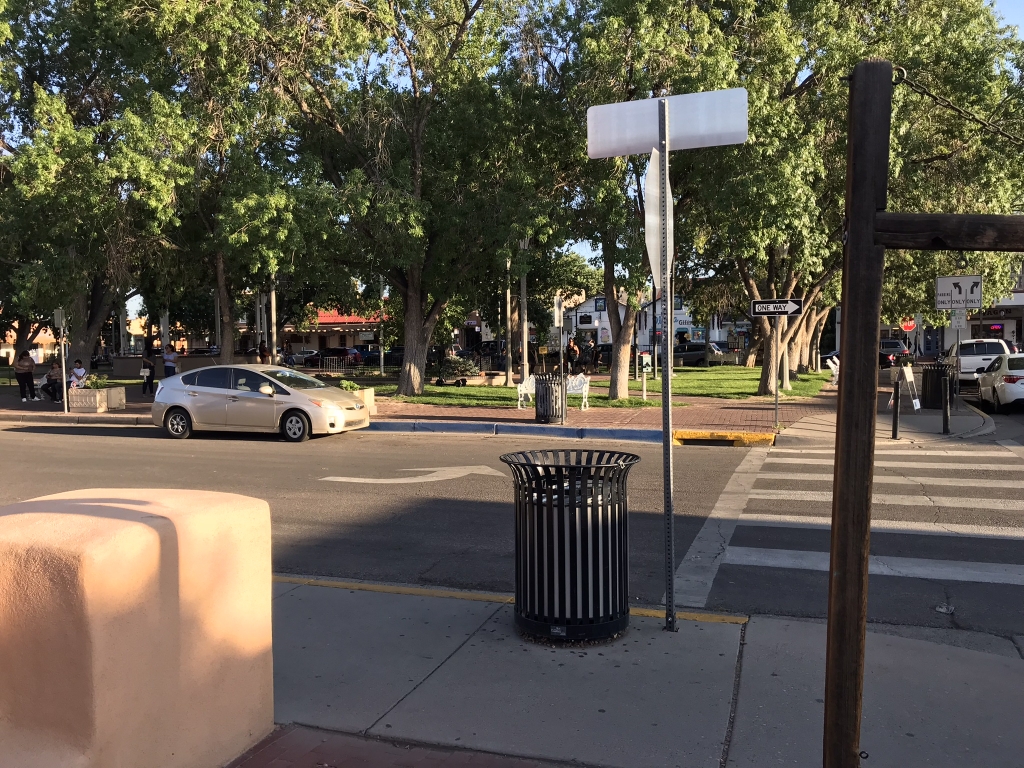
On my way to one more drinking establishment, I passed by this square. It looks just like the Zócalo in Santa Fe. Squares like this were a common feature of the cities that the Spanish built in the part of their empire called Mexico; you can find very similar squares in Mérida and nearly every other Mexican city, as well as older cities in the southwest US founded by the Spanish. In some cities it's called Zócalo, in others Plaza de Armas, in yet others various local names. Typically these green squares have a fountain or a gazebo somewhere in them, and the surrounding buildings often include shopping plazas, dining, a historic cathedral, and/or a Spanish governor's palace.
What's the Zócalo doing here and not in the center of the city? It seems that Old Town was the original Albuquerque--just as the French Quarter was the original New Orleans--and after it became part of the US, when English-speaking Americans started moving in, instead of moving into the city that was already there, they just started building all new neighborhoods and moved there. What is now downtown Albuquerque was the first such new addition, with all subsequent growth radiating from there, and the original city center becoming the quaint "Old Town" of today.
One last stop: Outpost 1706. This is my kind of beer bar, the kind with a huge selection of local craft beers. Marble Cerveza was a great Mexican lager, which I thought was better than the other Mexican lagers I'd had because it was foamier and didn't have a lime in it. Ex Novo Pilsner and Santa Fe brown ale were really tasty too. After that it was definitely time to stop so I had a glass of water and got an Uber to take me back to the hotel.
To be continued...

